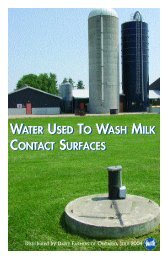Canadian Quality Milk On-Farm Food Safety Program - Centre ...
Canadian Quality Milk On-Farm Food Safety Program - Centre ...
Canadian Quality Milk On-Farm Food Safety Program - Centre ...
You also want an ePaper? Increase the reach of your titles
YUMPU automatically turns print PDFs into web optimized ePapers that Google loves.
<strong>Canadian</strong> <strong>Quality</strong> <strong>Milk</strong><br />
unstable and result in higher concentrations of antibiotic being injected<br />
into an animal.<br />
• Signature or initials of the person treating.<br />
When veterinarians administer an extra label treatment to an animal on the farm, the<br />
following options are acceptable:<br />
1) Leave written instructions detailing the treatment administered (e.g.<br />
animal, dosage, and withdrawal times).<br />
2) Initial the record in the producer’s treatment record.<br />
3) Have the producer record the treatments administered by the veterinarian<br />
and indicate that the veterinarian treated the animal.<br />
Ultimately, the producer is responsible to ensure that all treatments administered to<br />
dairy cattle are recorded.<br />
Record treatments for all cattle on the farm (e.g. calves, heifers, dry cattle, bulls,<br />
etc). Pesticides applied to an animal are considered treatments as well.<br />
Rule of Thumb:<br />
If a product has on the label or on the veterinary prescription:<br />
• A milk or meat withdrawal, producers must record its use.<br />
• No milk or meat withdrawal, producers do not need to record<br />
its use.<br />
If you treat a group of animals, separate treatment entries are not required for each<br />
animal, but each treated animal must be accounted for, for example, a range of animal<br />
identification numbers is adequate. It is also possible to record treatments of groups, as<br />
long as a producer can determine which animals were in which group at the specific<br />
time of treatment. A herd inventory may be necessary in this case.<br />
An animal’s common or barn name is not an adequate form of identification. Any<br />
eventual milker (e.g. relief milker) has to be able to identify each animal. If names are<br />
used, some system of permanent identification (e.g. list of names cross-referenced with<br />
ear-tag numbers) has to be available. Stall cards are not adequate either. Permanent<br />
identification, such as cow number, must be crossed-referenced on the stall card.<br />
Sample Options for Recording Repetitive and Multiple Livestock Treatments<br />
Purpose: to simplify record keeping for cows that receive the same treatment at<br />
every milking, and where groups of cows all receive the same treatment as often<br />
occurs with breeding synchronization programs. Both these situations often result in<br />
the use of animal health products that have a withdrawal for meat even if they do not<br />
have a withdrawal for milk. There is a need to ensure the safety of both milk and<br />
meat from these treated cows. If producers follow the procedures outlined below,<br />
they can simplify their records while minimizing the risk by observing any withdrawal<br />
periods before milking or shipping treated cattle.<br />
June 2010 4—21
















